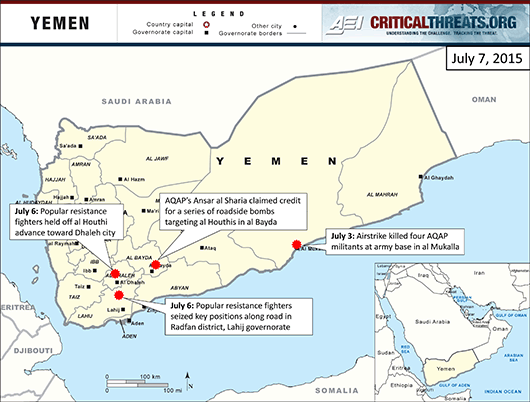Yemeni stakeholders have expressed that they are open to a humanitarian ceasefire, but an agreement has not yet been reached. Neither side of the conflict has made concessions in negotiations, despite increasing pressure from international actors and a growing humanitarian crisis inside of the country.
The security conditions in Yemen are directly contributing to a growing humanitarian emergency, which is increasing pressure for a ceasefire. The UN reported that there are 21.1 million people requiring humanitarian assistance in Yemen today, which is up from a February estimate of 15.9 million people in need of assistance. There are significant constraints on humanitarian access, including diesel shortages, insecurity along the roads, and limited ability to import aid. UN Special Envoy to Yemen Ismail Ould Cheikh Ahmed has been engaged in serious negotiations with al Houthi leaders in Sana’a, Yemen, and President Abdu Rabbu Mansour Hadi’s government in Riyadh, Saudi Arabia, and though both sides have expressed openness to a ceasefire, an agreement has not yet been reached. Saudi Arabia-led coalition airstrikes continue during the negotiations and killed the highest number of people to-date in a single day on July 6.
The al Houthi movement may be overstretched and unable to continue to hold the territory it had seized. Local popular resistance fighters have been able to regain control of some areas from the al Houthis, including along the road in Radfan district in Lahij governorate on July 6. Fighters in Dhaleh held off an al Houthi advance along the frontline in Wabeh area and Lakmat al Ashub, north of Dhaleh city. The al Houthis lost control of Dhaleh city at the end of May. Local reports indicate that anti-al Houthi forces trained in Hadramawt will be advancing on Aden to liberate the city and will also help to strengthen the local anti-al Houthi forces in Taiz, Abyan, and Lahij governorate. Fighters in Taiz continue to resist the al Houthis and took control of some sites in the city before withdrawing from them. Clashes between local fighters and al Houthis are also continuing in Aden, as are coalition airstrikes. A July 6 airstrike hit a marketplace in Fayoush, outside of the city, and killed over 45 civilians.
Ansar al Sharia, al Qaeda in the Arabian Peninsula’s insurgent force, continues its anti-al Houthi operations in al Bayda, Abyan, Shabwah, Ma’rib, Ibb, Lahij, and al Hudaydah. Ansar al Sharia’s primary effort is in eastern al Bayda governorate. There, Ansar al Sharia has been primarily targeting al Houthi patrols with roadside bombs. Ansar al Sharia has also claimed credit for similar attacks in Abyan, Shabwah, Ma’rib, and Ibb governorates. The group claimed it conducted a suicide vehicle-borne improvised explosive device attack against an al Houthi camp in al Hudaydah city and that it has clashed with the al Houthis there. Additionally, a new video produced through Ansar al Sharia’s media outlet and released on July 6, highlighted footage from clashes with al Houthis in unidentified areas of Shabwah governorate. (Statements and video obtained by SITE.) Finally, a reported U.S. airstrike killed four suspected Ansar al Sharia militants at an army base held by the group outside of al Mukalla, Hadramawt, on July 3. Ansar al Sharia has controlled al Mukalla through a proxy group since early April.
The Islamic State in Iraq and al Sham (ISIS) in Yemen was less active than weeks prior. A pro-ISIS Twitter account claimed that Wilayat Sana’a detonated three vehicle-borne improvised explosive devices (VBIEDs) in front of the central bank, “Friendship Bridge,” and a mosque in Sana’a on July 2. Witnesses reported a single VBIED attack near a mosque at the headquarters of the central bank on July 2, partially corroborating the Twitter account claims, though Wilayat Sana’a has not claimed any of the attacks.
Humanitarian conditions will continue to deteriorate in Yemen as security conditions worsen. Even with growing pressure, it is not clear that either side of the conflict is ready to make the necessary concessions to reach a ceasefire deal. Al Qaeda in the Arabian Peninsula and ISIS will continue to exploit the conditions on the ground to expand their influence.
← PREVIOUS |
NEXT → |

